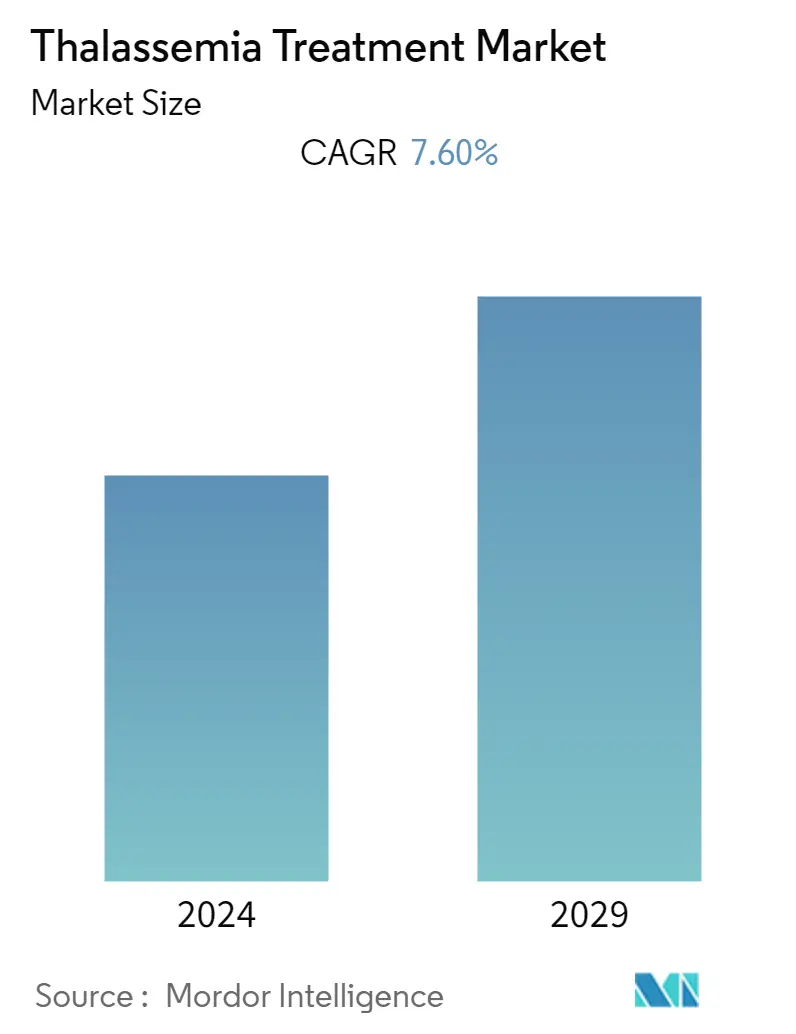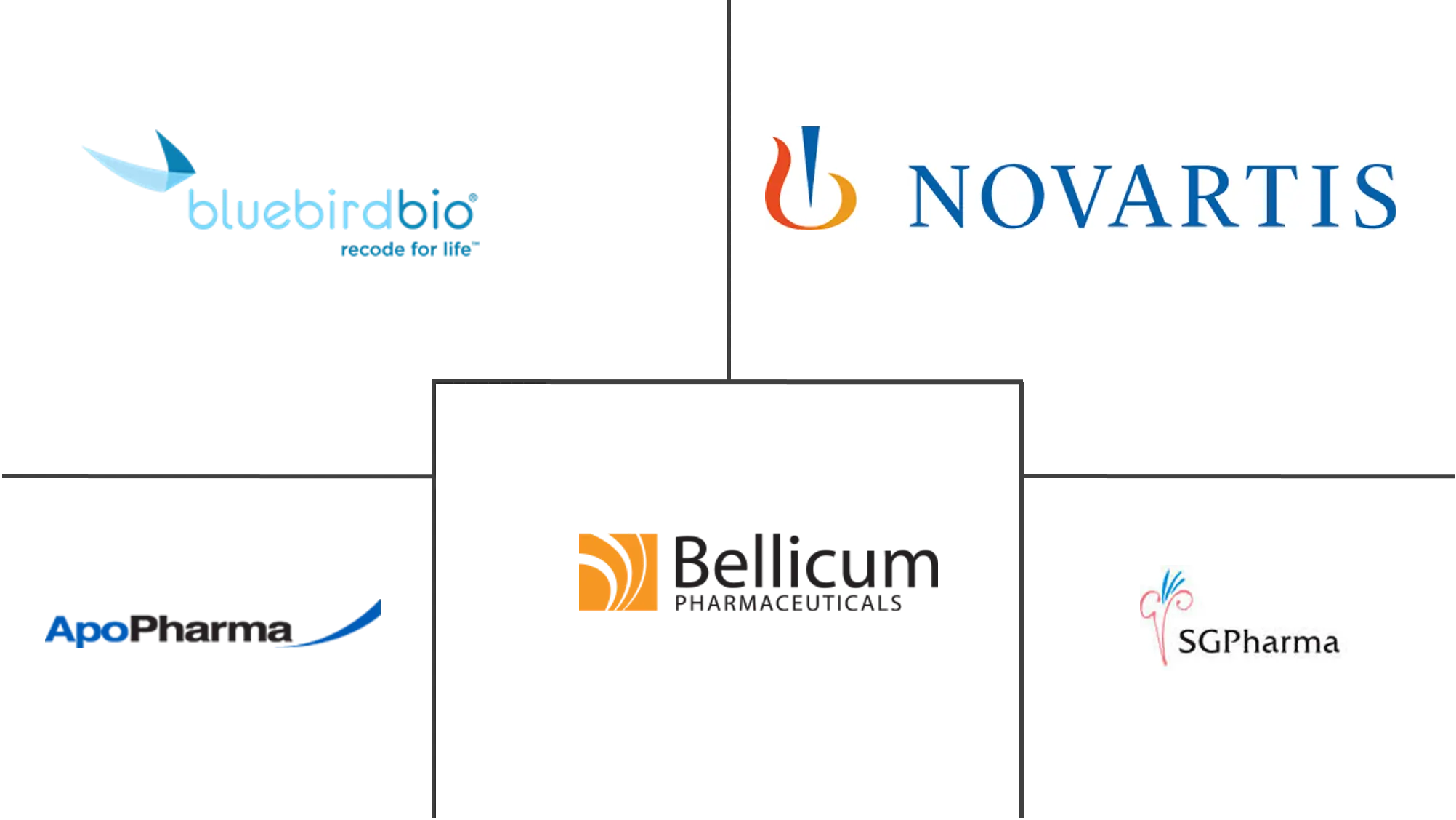
| Study Period | 2019 - 2029 |
| Base Year For Estimation | 2023 |
| Forecast Data Period | 2024 - 2029 |
| Historical Data Period | 2019 - 2022 |
| CAGR | 7.60 % |
| Fastest Growing Market | Asia Pacific |
| Largest Market | North America |
Major Players
*Disclaimer: Major Players sorted in no particular order |
Thalassemia Treatment Market Analysis
The thalassemia treatment market studied was projected to grow with a CAGR of nearly 7.6% over the forecast period. The major factors attributing to the growth of the market are increasing prevalence of thalassemia and also growing awareness to treat thalassemia. According to National Center on Birth Defects and Developmental Disabilities, thalassemia, affects at least 1,000 people in the United States. Furthermore the growing investements in research and development programs by the biotechnology and pharmaceutical companies boosting the market growth. Chelation therapy and blood transfusion are the conventional treatments for thalassemia patients, as these are cost effective and are easily available compared to bone marrow transplantation. Chelation therapy uses drugs such as deferasirox for the treatment of chronic iron overload occurs during multiple blood transfusions among non-transfusion-dependent thalassemia patients. Chelation therapy drugs used subcutaneous or intravenous with slow infusion method for purifying blood, raise the possibility of curing thalassemia in patients. However the high cost of the treatment is major drawback for the market growth.
Thalassemia Treatment Industry Segmentation
As per the scope of the report thalassemia is a blood disorder passed down through families in which the body makes an abnormal form or insufficient amount of hemoglobin. This report is segmented by Treatment Type, by Disease Type, by End-User, and by Geography.
| Blood Transfusions |
| Iron Chelation Therapy |
| Folic Acid Supplements |
| Others |
| Alpha Thalassemia |
| Beta Thalassemia |
| Hospitals |
| Research Institutes |
| Others |
| North America | United States |
| Canada | |
| Mexico | |
| Europe | Germany |
| United Kingdom | |
| France | |
| Italy | |
| Spain | |
| Rest of Europe | |
| Asia-Pacific | China |
| Japan | |
| India | |
| Australia | |
| South Korea | |
| Rest of Asia-Pacific | |
| Middle-East and Africa | GCC |
| South Africa | |
| Rest of Middle-East and Africa | |
| South America | Brazil |
| Argentina | |
| Rest of South America |
Thalassemia Treatment Market Size Summary
The thalassemia treatment market is experiencing significant growth, driven by the increasing prevalence of the disease and heightened awareness regarding its treatment. The market is characterized by substantial investments in research and development by biotechnology and pharmaceutical companies, which are contributing to its expansion. Conventional treatments such as chelation therapy and blood transfusion remain prevalent due to their cost-effectiveness and availability, despite the high costs associated with these treatments. Chelation therapy, in particular, plays a crucial role in managing chronic iron overload, a common complication in thalassemia patients, by using drugs like deferasirox. However, the high cost of these therapies poses a challenge to market growth.
North America is anticipated to lead the thalassemia treatment market throughout the forecast period, supported by the presence of key industry players, a high prevalence of thalassemia, and a well-established healthcare infrastructure. The region benefits from favorable government initiatives and an increase in research partnerships, which are expected to further drive market growth. The United States, in particular, holds a significant share due to rising awareness and a growing number of individuals with the thalassemia carrier gene. The market is moderately competitive, with major companies such as Bluebird Bio, IONIS Pharmaceuticals, and Novartis AG playing a dominant role.
Thalassemia Treatment Market Size - Table of Contents
1. MARKET DYNAMICS
- 1.1 Market Overview
-
1.2 Market Drivers
- 1.2.1 Rising Prevalence of Thalassemia
- 1.2.2 Increasing Awareness of Thalassemia Treatment
-
1.3 Market Restraints
- 1.3.1 High Cost of Treatment
-
1.4 Porter's Five Force Analysis
- 1.4.1 Threat of New Entrants
- 1.4.2 Bargaining Power of Buyers/Consumers
- 1.4.3 Bargaining Power of Suppliers
- 1.4.4 Threat of Substitute Products
- 1.4.5 Intensity of Competitive Rivalry
2. MARKET SEGMENTATION
-
2.1 By Treatment Type
- 2.1.1 Blood Transfusions
- 2.1.2 Iron Chelation Therapy
- 2.1.3 Folic Acid Supplements
- 2.1.4 Others
-
2.2 By Disease Type
- 2.2.1 Alpha Thalassemia
- 2.2.2 Beta Thalassemia
-
2.3 By End-User
- 2.3.1 Hospitals
- 2.3.2 Research Institutes
- 2.3.3 Others
-
2.4 Geography
- 2.4.1 North America
- 2.4.1.1 United States
- 2.4.1.2 Canada
- 2.4.1.3 Mexico
- 2.4.2 Europe
- 2.4.2.1 Germany
- 2.4.2.2 United Kingdom
- 2.4.2.3 France
- 2.4.2.4 Italy
- 2.4.2.5 Spain
- 2.4.2.6 Rest of Europe
- 2.4.3 Asia-Pacific
- 2.4.3.1 China
- 2.4.3.2 Japan
- 2.4.3.3 India
- 2.4.3.4 Australia
- 2.4.3.5 South Korea
- 2.4.3.6 Rest of Asia-Pacific
- 2.4.4 Middle-East and Africa
- 2.4.4.1 GCC
- 2.4.4.2 South Africa
- 2.4.4.3 Rest of Middle-East and Africa
- 2.4.5 South America
- 2.4.5.1 Brazil
- 2.4.5.2 Argentina
- 2.4.5.3 Rest of South America
Thalassemia Treatment Market Research FAQs
What is the current Thalassemia Treatment Market size?
The Thalassemia Treatment Market is projected to register a CAGR of 7.6% during the forecast period (2025-2030)
Who are the key players in Thalassemia Treatment Market?
Bluebird Bio, Novartis AG, ApoPharma Inc, Bellicum Pharmaceuticals and Pfizer, Inc. are the major companies operating in the Thalassemia Treatment Market.


